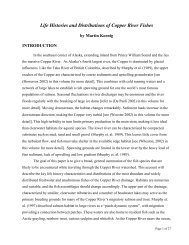Mitigation for the Construction and Operation of Libby Dam
Mitigation for the Construction and Operation of Libby Dam
Mitigation for the Construction and Operation of Libby Dam
You also want an ePaper? Increase the reach of your titles
YUMPU automatically turns print PDFs into web optimized ePapers that Google loves.
Table 1. Current relative abundance (A=abundant, C=common, R=rare) <strong>and</strong> abundance trend from<br />
1975 to 2000 (I=increasing, S = stable , D = decreasing, U = unknown) <strong>of</strong> fish species present in<br />
<strong>Libby</strong> Reservoir.<br />
Common Name Scientific name Relative Abundance Native<br />
abundance trend<br />
Game fish species<br />
Westslope cutthroat Oncorhynchus clarki lewisi C D Y<br />
trout<br />
Rainbow trout Oncorhynchus mykiss C D Y<br />
Bull trout Salvelinus confluentus C I Y<br />
Brook trout Salvelinus fontinalis R U N<br />
Lake trout Salvelinus namaycush R U N<br />
Kokanee salmon Oncorhynchus nerka A U N<br />
Mountain whitefish Prosopium williamsoni R D Y<br />
Burbot Lota lota C D Y<br />
Largemouth bass Micropterus salmoides R U N<br />
Nor<strong>the</strong>rn pike Esox lucius R U N<br />
Nongame fish species<br />
Pumpkinseed Lepomis gibbosus R U N<br />
Yellow perch Perca flavescens C I N<br />
Redside shiner Richardsonius balteatus R D Y<br />
Peamouth Mylocheilus caurinus A I Y<br />
Nor<strong>the</strong>rn pikeminnow Ptychocheilus oregonensis A I Y<br />
Largescale sucker Catostomus macrocheilus A S Y<br />
Longnose sucker Catostomus catostomus C D Y<br />
Reservoir <strong>Operation</strong><br />
<strong>Libby</strong> <strong>Dam</strong> is a 113-m (370-ft) high concrete gravity structure with three types <strong>of</strong> outlets:<br />
sluiceways (3), operational penstock intakes (5, 8 possible), <strong>and</strong> a gated spillway. The dam crest is<br />
931 m long (3,055 ft), <strong>and</strong> <strong>the</strong> widths at <strong>the</strong> crest <strong>and</strong> base are 16 m (54 ft) <strong>and</strong> 94 m (310 ft),<br />
respectively. A selective withdrawal system was installed on <strong>Libby</strong> <strong>Dam</strong> in 1972 to control water<br />
temperatures in <strong>the</strong> dam discharge by selecting <strong>of</strong> water various strata in <strong>the</strong> reservoir <strong>for</strong>ebay.<br />
Completion <strong>of</strong> <strong>Libby</strong> <strong>Dam</strong> in 1972 created <strong>the</strong> 109-mile <strong>Libby</strong> Reservoir. Specific<br />
morphometric data <strong>for</strong> <strong>Libby</strong> Reservoir are presented in Table 2. Filling <strong>Libby</strong> Reservoir<br />
inundated <strong>and</strong> eliminated 109 miles <strong>of</strong> <strong>the</strong> mainstem Kootenai River <strong>and</strong> 40 miles <strong>of</strong> critical,<br />
low-gradient tributary habitat. This conversion <strong>of</strong> a large segment <strong>of</strong> <strong>the</strong> Kootenai River from a<br />
lotic to lentic environment changed <strong>the</strong> aquatic community (Paragamian 1994). Replacement <strong>of</strong><br />
<strong>the</strong> inundated habitat <strong>and</strong> <strong>the</strong> community <strong>of</strong> life it supported are not possible. However,<br />
mitigation ef<strong>for</strong>ts are underway to protect, reopen, or reconstruct <strong>the</strong> remaining tributary habitat<br />
to partially <strong>of</strong>fset <strong>the</strong> loss. Fortunately, in <strong>the</strong> highl<strong>and</strong>s <strong>of</strong> <strong>the</strong> Kootenai Basin, tributary habitat<br />
quality is high. The headwaters are relatively undeveloped <strong>and</strong> retain a high percentage <strong>of</strong> <strong>the</strong>ir<br />
original wild attributes <strong>and</strong> native species complexes. Protection <strong>of</strong> <strong>the</strong>se remaining pristine<br />
areas <strong>and</strong> reconnection <strong>of</strong> fragmented habitats are high priorities.<br />
Between 1977 <strong>and</strong> 2000, reservoir drawdowns averaged 111 feet, but were as extreme as<br />
154 feet (Figure 3). Drawdown affects all biological trophic levels <strong>and</strong> influences <strong>the</strong><br />
probability <strong>of</strong> subsequent refill during spring run<strong>of</strong>f. Refill failures are especially harmful to<br />
23
















